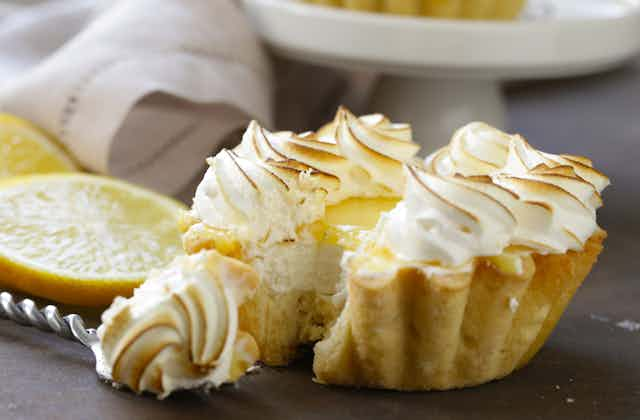Whether it’s frothing milk for a cappuccino or beating egg whites into meringue for a pavlova or macaroons, you can thank chemistry for the reactions that make them possible.
Beating egg whites with a whisk or frothing milk with steam disrupts – or partly “denatures” – the neatly folded and tightly curled chains of amino acids within milk or egg white protein.
Once disrupted, the amino acid chains unfurl and expand to take up more space. It’s a bit like unravelling a ball of wool. The extra space is the volume of froth on your coffee or the fluffiness of the meringue.
Go froth and multiply the bubbles
When frothing milk for a cappuccino, the steam and pressure denature both casein and whey proteins.
Understanding froth science helps create a better milky foam. The best froth, used in latte art, is called a microfoam.
Microfoam is made in two steps. First, you introduce air into milk by placing the tip of the steamer within the milk. Then you slowly bring it close to the top until the milk mixture starts to hiss.

Then you plunge the steamer tip deeper into the milk to create a whirlpool. This gently mixes the foam evenly throughout the milk so it becomes thick and velvety.
According to Coffeegeek, froth that is totally white on the top means you made too much foam, or it has not been mixed evenly through the milk.
If you overheat the milk, the protein gets totally denatured and can no longer form bonds across protein strands or incorporate enough air bubbles to make a decent froth structure.
Interestingly, skim milk can produce more froth with larger air bubbles because it has a higher protein content.
So what does coffee froth have to do with meringue?
Boom meringue
Compared to milk, the amino acid chains in egg white albumen are much longer. Like knitting, if you have a bigger ball of wool, you can knit a longer scarf.
So when egg white protein chains unfold, they can incorporate a lot more air between their stretched amino acid strands compared to milk proteins.
Exploratorium science provides more detail on how beating also exposes some amino acids that repel water – i.e. are “hydrophobic”.
When egg whites get beaten, these water-wary amino acids come into close contact with other water-loving (i.e. hydrophilic) amino acids. Next, water molecules from egg whites, the air and amino acids all jockey to get into the best possible position to be near components they like, and to get as far away as possible from the ones they do not like.
They incorporate air into the structure to help them do this. Some of the amino acid strands also make “bridges” between them to try to stabilise the meringue. This is why meringue does not deflate as much as cappuccino froth.
When the whipped-up egg white is cooked, ovalbumin – the main protein in egg white – becomes completely denatured, meaning it cannot return to its former shape. This is what makes meringue solid.

Exploratorium’s science of cooking eggs includes hints on using chemistry to make better meringue. Try these:
Use a metal bowl. Clean plastic bowls still hold tiny molecules of fat. These get in the way when amino acid chains try to network and block air being incorporated into the foam. (This is another reason why skim milk froths better than full-cream milk.)
Add a drop of vinegar or lemon juice. These acidic liquids donate positively charged hydrogen ions to negatively charged protein strands, neutralising them. This slows down the rate at which new bonds between the amino acid chains are made and gives more time for them to unfurl and incorporate air while being beaten.
Use eggs at room temperature. Warmer egg whites will foam up better than cold ones from the fridge. This is because the proteins strands can move more at the higher temperature and are already starting to unfurl. It’s a bit like being given a head start in a race to unravel a ball of wool.
Cappuccino versus meringue
When it comes to a battle of strength, meringue foam beats cappuccino froth. Milk froth is less stable than egg white foam. This is why your frothy coffee will flatten if you leave it to sit, while a cooled pavlova holds its structure for quite a while.
Egg white has more sulphur-containing amino acids than milk protein, which means it can make very strong disulphide bridges between amino acids across protein strands when beaten. These hold the fully denatured proteins in their new shape.
The changes foods undergo during cooking are really food chemistry reactions. So next time you’re enjoying a coffee and a macaroon, you can thank chemistry for the froth and the crunch.

